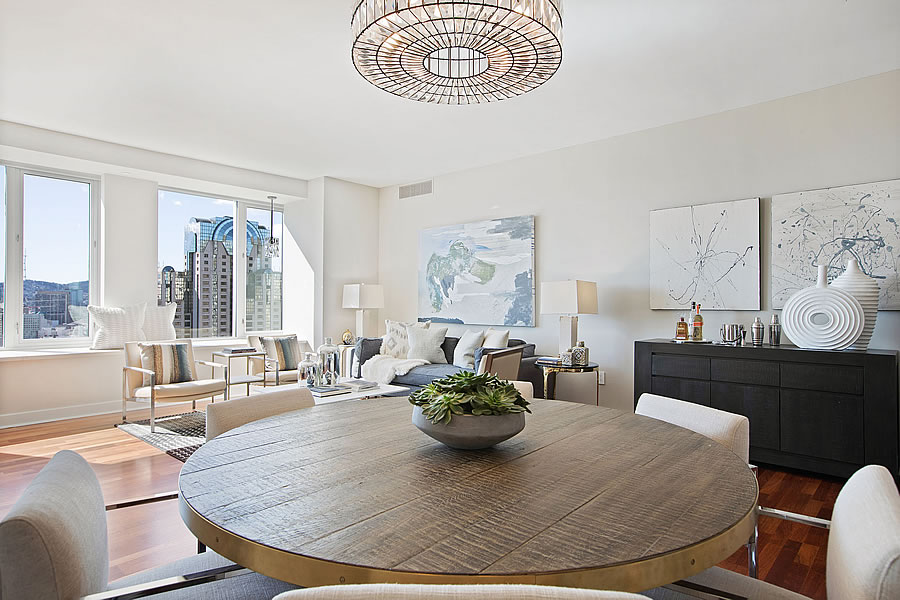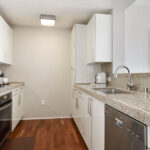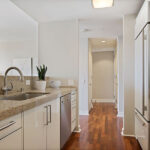As we outlined earlier this year:
Back in 2007, the 1,670-square-foot, two-bedroom unit #27C in the St. Regis Museum Tower building at 188 Minna Street quickly fetched the $2.75 million price at which it was listed, financed by the Hong Kong-based Bank of East Asia.
Featuring “one of St. Regis’s most desirable floorplans,” with “skyline views across San Francisco from every room” and access to five-star building amenities, including butler service, the unit returned to the market priced at $3.08 million in March of last year.
Reduced to $2.7 million [in June of last year], the luxury unit was then withdrawn from the MLS at the end of [2019] and re-listed anew in January with a (further reduced) price tag of $2.53 million and an official “1” day on the market, a contract price at which the sale, which is now pending, would be considered to be “at asking” according to all MLS-based stats but 8 percent below its 2007-era value on an apples-to-apples basis, with some ups and downs between.
And the sale of 188 Minna Street #27C has now closed escrow with a contract price of $2.3 million, representing a 16.4 percent ($450K) drop below its 2007-era value on an apples-to-apples, versus “median price,” basis.









An example why building even “luxury housing” still benefits in bringing prices down. When the St. Regis was completed in 2005, it was one of the earliest and one of the only luxury condo towers in SF, hence fetching the price it did. Today, with dozens more of similar luxury towers and more options for buyers (who may not be interested in paying the high HOA fees), the St. Regis is now cheaper. For a bit more than the original 2007 price, isn’t it almost enough to get a 2 bed at 706 Mission (though maybe a lower and less desirable floor)
This is a completely different market segment than workforce housing. Prices will only fall so far.
Barring some catastrophic gutting of San Francisco, units at the St Regis are never going to be affordable to teachers or waiters, no matter how many more luxury towers are built.
You are right, buildings like the St Regis will probably never be affordable to teachers or waiters, no matter how many are built. However, enough new construction at the high end of the market will make it less lucrative to flip decrepit rent controlled apartments into upscale condos – or in the case of a building like 628 Shotwell, to flip a 6 bed board and care facility into a duplex. I’m not saying that the city can dig itself out of the housing crisis by only building “luxury housing” like the Saint Regis. Rent control and public financing of affordable housing are essential tools in the toolkit. But not allowing any room for new “luxury housing” will simply condemn us all to playing a game of musical chairs in which the wealthy always win.
Building a glut of luxury stock seems like an inefficient way to preserve, let alone add to, the stock of affordable housing. Building housing that is affordable is a much more efficient way, and one which doesn’t become fuel for speculative bubbles that can take down entire economies.
Agreed that luxury housing isn’t the ideal solution, but more supply of housing is better than no supply. It seems like many of the sf progs (Ronen, Peskin) think the solution is to prevent any development that isn’t 100% affordable, which makes it impossible to build any housing at all since the funding isn’t there. IMO, all new development in SF should have a 20% affordability minimum, that if is met, should be fast tracked.
“[…]more supply of housing is better than no supply.”
Define “better.”
If your objective is higher housing costs, building into higher market segments gentrifies neighborhoods and increases land values, and makes housing more unaffordable.
If your objective is providing housing that is affordable to the people who teach your kids, drive the buses, and sling your latte, then building more high-end supply is worse than adding no supply.
Gentrification is racism and top-down class warfare.
A more appropriate floorpan for a luxury unit, where you don’t look into a bathroom from the dining room or kitchen as in many new buildings.
23C in the same stack but 4 floors below sold for $3.15M when things were just getting started in 2014. So this one was probably worth about $3.2 in 2014, and then 20% more, about $3.8, at the peak in 2017. So it was worth (3.8-2.3)/2.3, or 65% more at the peak than it’s worth today. That’s just stunning, all in 3 years.
As news spreads of this loss and others generally, I take it Asian buyers will start looking for greener pastures, which will only accelerate the future losses.
I don’t know. Seems to me like the HOA fees are so high compared to other buildings that we might want to consider them a signalling mechanism to purchasers: “if you have to ask what the HOA fees are, you can’t afford the unit”, that kinda thing. As such this decline in price might not have too much indicative quality for the market overall, even at the high end.
Its high HOA fees are partly attributable to its connection with the 5-star hotel services available, even if they’re not used.